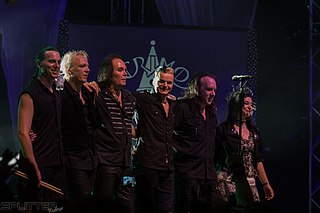
Lacrimosa is a Swiss gothic metal band led by German musician Tilo Wolff, who is also the main composer, and Finn Anne Nurmi. They are currently based in Switzerland, but originally from Germany. Originally counted among the bands of the Neue Deutsche Todeskunst genre, Lacrimosa are most commonly associated with the gothic metal genre.

Nightwish is a Finnish symphonic metal band from Kitee. The band was formed in 1996 by lead songwriter and keyboardist Tuomas Holopainen, guitarist Emppu Vuorinen, and former lead singer Tarja Turunen. The band soon picked up drummer Jukka Nevalainen, and then bassist Sami Vänskä after the release of their debut album, Angels Fall First (1997). In 2001, Vänskä was replaced by Marko Hietala, who also took over the male vocalist role previously filled by Holopainen or guest singers. Although Nightwish have been prominent in their home country since Angels Fall First, they did not achieve wider success until the release of the albums Oceanborn (1998), Wishmaster (2000) and Century Child (2002).
Symphonic black metal is a subgenre of black metal that emerged in the 1990s and incorporates symphonic and orchestral elements.

Power metal is a subgenre of heavy metal combining characteristics of traditional heavy metal with speed metal, often within a symphonic context. Generally, power metal is characterized by a faster, lighter, and more uplifting sound, in contrast with the heaviness and dissonance prevalent in, for example, extreme metal. Power metal bands usually have anthemic songs with fantasy-based subject matter and strong choruses, thus creating a theatrical, dramatic and emotionally "powerful" sound.
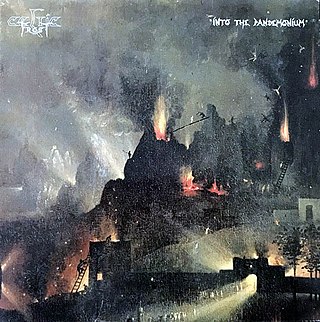
Into the Pandemonium is the third studio album by Swiss extreme metal band Celtic Frost, released in 1987. The album marks the return of bassist and backing vocalist Martin Eric Ain, who appeared on 1984's Morbid Tales, but not the band's previous album.
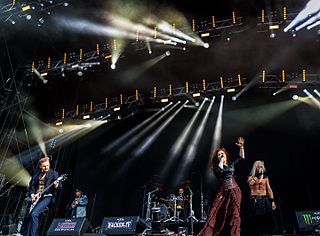
Therion is a Swedish symphonic metal band founded by Christofer Johnsson in 1987. Its name was inspired by the Celtic Frost album To Mega Therion. "To Mega Therion" is Greek for "The Great Beast" and was a title used by occultist Aleister Crowley. Originally a death metal band, Therion adjusted its musical style by adding orchestral elements, including choirs, classical musicians, and even a full orchestra at their concert performances. As a result, they are considered pioneers of the symphonic metal genre.
A number of heavy metal genres have developed since the emergence of heavy metal during the late 1960s and early 1970s. At times, heavy metal genres may overlap or are difficult to distinguish, but they can be identified by a number of traits. They may differ in terms of instrumentation, tempo, song structure, vocal style, lyrics, guitar playing style, drumming style, and so on.
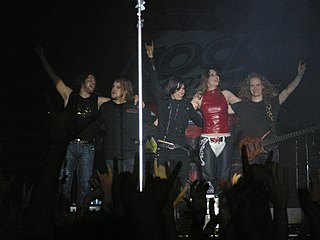
After Forever was a Dutch symphonic metal band with strong progressive metal influences. The band relied on the use of both soprano vocals and death growls.
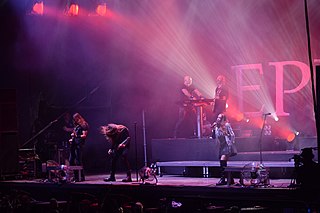
Epica is a Dutch symphonic metal band, founded by guitarist and vocalist Mark Jansen after his departure from After Forever.

Tarja Soile Susanna Turunen-Cabuli, known professionally as Tarja Turunen or simply Tarja, is a Finnish heavy metal singer, best known as the former lead vocalist of Nightwish.
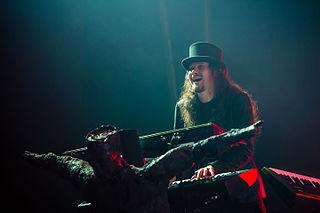
Tuomas Lauri Johannes Holopainen is a Finnish musician, songwriter, and record producer, best known as the primary songwriter, keyboardist, and a co-founding member of symphonic metal band Nightwish. He has stated that his songwriting is influenced by harmonic film music.

Invisible Circles is the third studio album by Dutch symphonic metal band After Forever. It was released on 25 March 2004, by the small Dutch label Transmission Records. It is After Forever's first full-length album since the dismissal of guitarist and composer Mark Jansen, whose musical tastes had strongly influenced the sound of their first work Prison of Desire (2000) and their successful second offering Decipher (2001). In this work After Forever choose a new musical direction, mostly revolving around elements of progressive metal instead of the gothic and symphonic metal of previous albums. The creative process for Invisible Circles took more than a year and required the use of three recording studios in the Netherlands and Germany. A long tour to support the album brought the band to some of the most important European rock festivals and to Central and South America.

Markus H. J. Jansen is a Dutch guitarist, vocalist, and songwriter. A prominent figure in the symphonic metal subgenre, he is known for his work with the bands After Forever (1995–2002), Epica (2002–present), and MaYaN (2010–present).
Gothic metal is a fusion genre combining the aggression of heavy metal with the dark atmospheres of gothic rock. The music of gothic metal is diverse with bands known to adopt the gothic approach to different styles of heavy metal music. The genre originated during the early 1990s in the United Kingdom originally as an outgrowth of death-doom, a fusion of death metal and doom metal. Lyrics are generally dark and introspective with inspiration from gothic fiction as well as personal experiences.

The Heart of Everything is the fourth studio album by Dutch symphonic metal band Within Temptation, released by GUN Records on 12 March 2007 in Europe. It was released in North America on 18 June 2007 by Roadrunner Records. The album follows the symphonic metal sound the band had been improving and deepening until then, and is considered by lead vocalist Sharon den Adel as the album in which the band finally managed to achieve this kind of sound.

Destroy Destroy Destroy is an American melodic death metal band formed in Murfreesboro, Tennessee in February 2003. With a lineup of rhythm guitarist Jeremiah Scott, vocalist Bryan Kemp, and drummer Andrew Hall, they began writing songs; soon thereafter Destroy Destroy Destroy completed their outfit with lead guitarist Way Barrier, bassist Adam Phillips and keyboardist Brian Shorter. The group then started playing shows locally and recorded a self-financed EP entitled Kill or Be Killed. They have released two studio albums, Devour the Power (2006) and Battle Sluts (2009), both through Black Market Activities. Destroy Destroy Destroy played their first show in a pizzeria as opening band for Mastodon.

The Classical Conspiracy is the second live album by Dutch symphonic metal band Epica. The recorded live show took part in Miskolc, Hungary on 14 June 2008 in the framework of the Miskolc Opera Festival, where the Swedish symphonic metal band Therion had done a similar show a year before. Epica performed on stage with a 40-piece orchestra and a 30-piece choir, entirely composed of Hungarian musicians conducted by Zsolt Regos. The expanded ensemble played classical music, excerpts from operas and movie soundtracks, as well as Epica's songs. The album was released on 8 May 2009 through Nuclear Blast Records.
Coronatus is a German gothic metal band, formed in Ludwigsburg in 1999.

Manuela Kraller is a German spinto soprano singer. She is best known as the former lead singer of symphonic metal band Xandria from late 2010 until late 2013. She was formerly one of the soprano vocalists in the symphonic metal band Haggard. She now has a project that strays away from the metal scene and more of a classical style instead that's called "Valkea Valo" with her friend Tobias Gut.

























